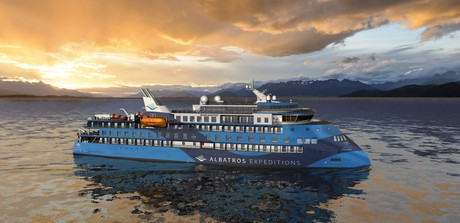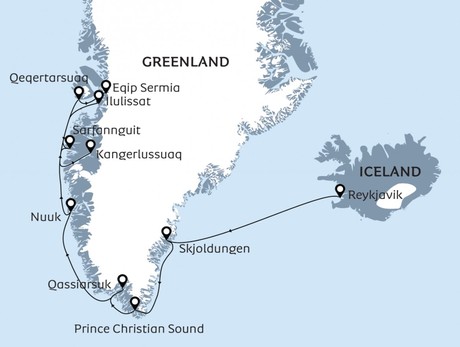In the Wake of Eric the Red - Greenland Expedition
Join us on an expedition cruise from Reykjavík to Kangerlussuaq, following the same maritime course set by Norse settlers over a thousand years ago. Experience the diversity of East, South and West Greenland, from the bustling mini-metropolis of Nuuk to the spectacular icebergs of Sermilik all in one unique voyage!
Join us on a thrilling expedition cruise from Reykjavík, following the same maritime course set by Norse settlers over a thousand years ago. While the spectacular scenery of this region remains untouched, thankfully our purpose-built expedition ship offers significantly more comfort and style than a Viking longship! Our first destination is the rugged shores of East Greenland, an ancient land steeped in mythology and ancient Inuit tradition. Here we will experience Tunumiit culture in the bustling towns of Tasiilaq and Kuummiut, learn about Greenland's fascinating modern history at Ikateq, and witness the icy majesty of Sermilikfjord, one of Greenland's most spectacular sights. From here, we will chart a course for the glassy waters and perfect silence of Skjoldungen Fjord on Greenland's southeast coast, after which we will sail through the magnificent strait of Prins Kristiansund, the glacier-lined channel separating Kap Farvel (Greenland's southernmost point) from the mainland, before venturing deep into the fjords of South Greenland.
The lush green fields and rolling hills of South Greenland make it easy to see why the Norse gave the island the name it bears to this day - and why the Norse chose to settle in this green paradise. Here we will to visit the ancient remains of Brattahlíð, Erik the Red's former farmstead in the small farming village of Qassiarsuk, and trek across to Igaliku, once the seat of the Norse Bishops of Greenland.
Following the magnificent coastline of Earth's largest island, we will visit Nuuk, one of the smallest (but no less perfect) world capitals. With everything you would expect from a capital city, including skyscrapers, exceptional museums and boutique shopping, Nuuk still has a strong Greenlandic vibe; tiny traditional wooden houses sit in the shadow of glassy towers, and locals buy seal and whale meat at the city market. The city also has a few charming oddities- including the only traffic lights in Greenland!
From Nuuk, we will pass by the village of Kangaamiut, a town steeped in Greenlandic culture and tradition which sits on the edge of the a maze of fjords, islands, mountains and glaciers. In the afternoon, we will venture into the nearby Eternity Fjord to experience this astounding natural beauty.
Join us onboard Ocean Albatros for an enriching experience combining Nordic and Inuit culture and the natural wonders of the Arctic!
The rock-like columns of Hallgrímskirkja Church loom over the city of Reykjavík, a hip Scandinavian capital which needs little introduction. With new Nordic cuisine, excellent shopping, fantastic excursions and an easy relaxed vibe, Reykjavik is one of Scandinavia's most welcoming and exciting cities. Situated in the centre of the North Atlantic, Reykjavík is the perfect place to start Arctic adventures!
Our purpose-built expedition vessel awaits in the city's bustling harbour, awaiting to welcome our guests. After the madatory safety drill, enjoy dinner and a glass of champagne as we follow the thousand-year-old Norse sea route towards Greenland.
As Norse explorers once did, we will cross the Denmark Strait from Iceland to Greenland. Days at sea are never dull. We will arrange a variety of activities onboard for our guests to enjoy to engage the mind, body and soul. Join your knowledgeable Expedition Team lecturers in the Theatre to hear specially-crafted lectures on local history, wildlife, geology, culture and more, unwind with a massage in the Albatros Polar Spa, or simply watch the seabirds gliding along with the ship from our hot tubs, as your expedition vessel flies across the Denmark Strait.
Our first port of call in Greenland is Tasiilaq, the largest settlement in East Greenland. Unlike the west coast, which has had uninterrupted contact with Europe since the 1700s, the coast of East Greenland remained more or less uncontacted until around 1894, when a Danish trading post was established at Tasiilaq. The vast distances involved in Arctic travel meant that the people of East Greenland (Tunumiit) were isolated from their cousins to the west, and the language, traditions and culture of East Greenland therefore differ significantly to those in other parts of the country.
Ancient traditions are strong here. This region of Greenland was the home of the last Angakkuit (Shamans) of Greenland, and is the home of the tupilak - a monster fashioned from animal (and sometimes human) body parts and animated by the power of an Angakkuq to wreak havoc on enemies. Creating such a monster was dangerous, as it could be turned back by a more powerful magic user to attack its creator. The first Europeans were curious as to what these dark beasts looked like, and locals carved facsimiles in bone or horn, beginning one of Greenland's finest artistic traditions. The tupilaat made by artisans in Tasiilaq are considered among the best in the country.
Tasiilaq sits in a perfect natural harbour on Ammassalik Island (meaning 'the Place of Many Capelin'). While superficially similar to towns on the West Coast, the landscape here is much more rugged, the people fewer, and the sled dogs much more numerous. Tasiilaq offers excellent opportunities to explore, with excellent hiking routes such as the Flower Valley easily accessible from town. For those wishing to delve into Tunumiit culture, visit the museum, located in the city's old church, hear the city's exquisite choir perform in the modern church, or watch a drum dancer in traditional East Greenlandic costume perform a millennia-old spiritual tradition. For those wishing to indulge in some retail therapy, visit the Stunk Artist's Workshop, where skilled craftsmen create beautiful pieces from natural local materials. Otherwise, hike up the hill towards the hotel to enjoy some of the best views anywhere in the country.
In the morning, we will sail slightly eastwards towards Ikateq, a spectacular fjord with a fascinating history. During the darkest days of the Second World War, American forces established an airbase here (one of the network of air bases which includes Kangerlussuaq on the west coast) to serve as a stepping stone for aircraft transiting between Europe and North America. The rugged landscape of East Greenland meant the approach into the airport was hazardous, with frequent fog masking the treacherous mountains. Huge recources were invested into Ikateq Airbase (also known as Bluie 2 East), with a 5,000ft runway, hangar, barracks and port constructed. A fleet of military vehicles and thousands of barrels of fuel were also brought to this remote region. With Germany defeated, improvements to intercontinental aircraft, and increasing tensions with the Soviet Union, the United States Military abandoned the base in 1947, leaving almost everything behind.
The air base has been a bone of contention between Nuuk, Copenhagen and Washington for many years. Many in the Greenlandic government wanted the site cleaned up and the ruins removed; an expensive and logistically challenging task. Eventually, the Danish Government agreed to remove hazardous waste from the site (mainly decaying fuel drums), but leaving the rest of the equipment in place as an important part of regional history. Over 75 years later however, almost everything remains as it was on the day the Americans left. Ikateq is a truly unique place, a time warp to the Second World War: eerie, fascinating and surrounded by staggering natural beauty.
We will spend the afternoon in the small village of Kuummiut, which sits in breathtaking surroundings in the calm reaches of Ammassalik Fjord. Kuummiut - meaning 'People who Live by the River' - is one of the larger villages in the area, and one of the most prosperous. Sitting upon some of East Greenland's richest fishing grounds, Kuummiut holds the only fish factory in the region, and fishermen from miles around come through Ammassalik Fjord (which is wide enough to stay mostly ice-free year-round) to sell their catch here.
Kuummiut is an ideal place to experience life in an East Greenlandic settlement. Where other towns have traffic, Kuummiut has the yowling of sled dogs and the sigh of the wind through the grass. No roads lead in or out of this isolated village, and the sea is the highway for local transport - although motorboats have replaced the skin boats which brought people to these shores long ago. It is a perfect place to simply sit, watch the icebergs pass, and perhaps see the whales which often frolic in the calm waters offshore.
From Kuummiut, we will continue to navigate through the labyrinth of fjords, heading towards Sermilik.
Separating Ammassalik Island from the Greenlandic mainland lies the vast Sermilik Fjord. Sermilik is a typically descriptive Greenlandic placename, roughly meaning 'the Glacial Fjord' and it is no mystery why: this waterway is choked with vast icebergs, and surely ranks among the most spectacular natural wonders of the region. The icebergs here mostly originate at the vast Helheim Glacier, one of the largest glaciers in this icy country. The Helheim and other glaciers which empty into the fjord pour directly off the Greenland Ice Sheet, the edges of which can be seen to the east, rising thousands of metres towards the frozen core of this vast island.
The volume of ice will dictate our precise activities in Sermilikfjord, although options include coming ashore to marvel at the spectacular scenery and untouched nature of the area, or exploring on the water and marvelling at the natural ice sculptures of the area on a Zodiac cruise through the icebergs. Whatever we do, prepare to be amazed by the jaw-dropping beauty of this otherwordly place.
Today's adventure begins as we sail into magnificent Skjoldungen, a staggeringly beautiful fjord on the southeastern coast of Greenland. The fjord is named for Skjold, an ancient Danish King of legend, while the Greenlandic name, Saqqisikuik, references the sunny climate of the area. Various archaeological finds on the island which sits in the middle of the fjord suggests nomadic Inuit groups visited and stayed in the area in years gone by; more recently, settlers were brought from Tasiilaq to settle the island in the 1930s, but returned there thirty years later;some houses can still be seen on the southern side of the fjord. A small weather station was also operated on the island by the Allies during WWII.
Today uninhabited, Skjoldungen sits almost 300km from the nearest village, with Mother Nature its only ruler. Vast saw-toothed mountains lined with opalescent glaciers line the deep chilly waters of the fjord, which can freeze even in summer. At the head of the fjord lies the magnificent Thryms Glacier, a magnificent river of ice flowing down from the ice sheet. On the southern side of Thryms Glacier lies the sweeping U-shaped glacial valley of Dronning Maries Dal - a textbook example of a glacially-produced landscape. Join your expedition team for a walk on the flower-lined floor of this valley, and marvel at the stunning scenery. Ensure you are on the outer decks on our approach and departure from this magnificent fjord too: you will not be disappointed!
South of Skjoldungen lies Kap Farvel, or Cape Farewell, which is renowned not only as Greenland's southernmost point, but also for its infamously challenging weather, which commonly features large swells and gale-force winds.
With this in mind, we deliberately opt for a far more comfortable but also more spectacular route, cruising via the inside passage of Prins Christian Sund. Known in Greenlandic by it's typically descriptive name of Ikerasassuaq ('the Big Strait'), this 60 km long waterway reaches from the entrance on the southeastern coast of Greenland to the small village of Aappilattoq, connecting the Labrador and Irminger Seas.
Prins Christian Sund is one of the most spectacular waterways anywhere on Earth. Kept free of ice year round by strong tidal currents, the strait is hemmed in on either side by mountains which rise straight out of the water some reaching over 2,000m in height. Large glaciers flow from the ice sheet into the sea on the northern side of the strait, while sapphire blue mountain glaciers loom over the water from the southern side, and vast icebergs stud the glassy waters.
In the afternoon, we will approach the small village of Aappilattoq, which sits hunkered beneath the towering mountains at the end of Prins Christians Sund. The village is a world away from busy Tasiilaq or even Kuummiut; life here moves at a slower pace, following the rhythms of the wind, waves and tides. Aappilattoq (meaning 'Red' in Greenlandic, referring to the stark granite bluffs above) offers excellent hiking opportunities, and the local choir is renowned throughout Greenland.
During the early morning, Ocean Albatros will sail through the majestic mountains of Tunulliarfik Fjord towards the small beach of Itilleq. The southern fjords of Greenland offer a very different environment to the chilly north and east of the country. Situated at roughly 60°N, this region is level with northern Scotland or southern Scandinavia, with a climate to match. Here, the weather is calm, stable and humid, with much warmer summers and milder winters than the rest of the country. In place of rocky hillsides, the fjords here are lined with lush green meadows and dotted with small sheep-farming settlements, of which Qassiarsuk and Igaliku are perhaps the best known.
Coming ashore in the morning at the sheltered bay of Itilleq, a farm trail beckons us to the village of Igaliku. During the morning, we will trek through the lush green hills to see the remains of the Norse Bishop's palace at Garðar - once a place of great power and influence in this remote corner of the Norse world.
During the afternoon, we will reposition to the other side of the fjord to the sheep-farming village of Qassiarsuk. While the modern village was founded in 1924, the location has a fascinating and much longer history; it was here that legendary Norse explorer Eric the Red settled after being banished from Iceland. He named the land he discovered 'Greenland' to encourage other settlers to follow him - a marketing ploy that has stood for over a thousand years!
Erik the Red settled in this green landscape and set up a small farmstead in typical Norse style, naming his new home 'Brattahlíð'. Erik himself kept fiercely to the Norse gods, but his wife Thjodhild was a Christian. Legend has it, she refused to join his bed until he built her a church, which he eventually did, constructing a tiny hut (Þjóðhildarkirkja) which was nevertheless the first church in the Americas (although he refused to have it within view of his house).
The Norse settlers in Greenland stayed for almost 500 years, but disappeared from all historical records in the early 1400s. Whether some plague or famine struck them, or whether deteriorating climate simply forced them to return to Scandinavia remains a topic of lively debate. Today the outlines of buildings (including Erik's house, Thjodhild's church and the Bishop's palace) can be seen, along with stunningly accurate reconstructions of Eric's farm, where modern Inuit farmers continue to raise sheep to this day. A statue of Erik now overlooks the area, commemorating the first European to reach the Americas, and whose son Leif would be the first European to reach Baffin Island and Newfoundland. Sites rich in fascinating history and culture old and new, the settlements of Brattahlíð and Garðar are today part of the Kujataa UNESCO World Heritage Site.
From South Greenland, we will follow the rugged coast of this vast island northwards. All settlements in Greenland (with the exception of Kangerlussuaq) are situated directly on the ocean coast of the country, and the vast majority of residents (some 50,000 or so) live on the narrow strip of coast on the west of the country, facing the Davis Strait.
Ocean currents bring warm water up from the Atlantic to the west coast, enriching these wildlife-filled waters. During our day at sea, keep your eyes on the sea! Whales, seals and a huge variety of seabirds are common in these rich waters.
A mixture of skyscrapers and traditional wooden houses, the quaint and the cosmopolitan, Nuuk is a city of contrasts. The vibrant bustling capital of Greenland, Nuuk feels much larger than it’s 19,000 inhabitants, and offers a wealth of experiences to visitors. The calm fjords around Nuuk have been inhabited by Paleo-Inuit cultures since at least 2200BCE, and archaeological evidnece indicates waves of migration through the area as ancient hunters followed migrating prey. Around the year 100CE, Norse colonist from Iceland etablished the Western Settlement in the green meadows of Nuuk Fjord; these settlers mysteriously disappeared several hundred years later leaving the island to the Inuit, who were far better equipped to live in Greenland's harsh environment.
The next Scandinavian to visit the area was Hans Egede, the controversial Danish missionary who 'rediscovered' Greenland, founding Nuuk as Godthåb ("Good Hope") in 1728. Danish initiatives to modernise Greenland in the 1950s left a significant mark on Nuuk. While they brought significant improvements to the city's infrastructure, the many large apartment blocks in the city attest to rapid (and sometimes haphazard) urbanisation. In 1979, the Home Rule Act created the Greenlandic Parliament (Inatsisartut), and proclaimed Nuuk the capital. The city's population continues to rapidly grow, with new suburbs being constructed beneath Ukkusissat, the mountain which looms to the east of the city.
Nuuk offers a huge amount to the discerning visitor; larger than any other city in Greenland, Nuuk has a bustling cosmopolitan vibe, and hosts some of Greenland's best attractions. Swing by Kolonihavn district to visit the Greenlandic National Museum, a treasure trove of history stretching back to the first inhabitants of this icy island - including artefacts from the Paleo-Inuit and Norse periods, as well as the spellbinding Qilakistoq mummies. Explore Greenlandic culture at Katuaq, the city's cultural centre and an architectural marvel; shop for authentic Greenlandic artworks in the city's many boutique shops, or simply relax at a hip curbside café with a Greenlandic coffee and watch this vibrant city in action. Nuuk York (as proud locals call it) is unlike any other city in Greenland, or indeed the world.
On the last full day of our expedition, we will arrive at the small village of Kangaamiut, an incredibly picturesque settlement in Greenland’s central Qeqqata region. Surrounded by cold rich waters and a vast back country brimming with game, life in Kangaamiut moves at a slower pace, and locals still live a largely traditional lifestyle, surviving by hunting and fishing. Hike to the heliport atop the hill for stunning views over the town and the surrounding fjordlands, or meet the friendly local people during a display of traditional clothing, foods, and seal-flensing. The artists of Kangaamiut are well-known throughout Greenland, and some of the locals' most splendid work can be viewed in the town's small museum.
In the afternoon, we will sail inland into Evighedsfjorden/Kangerlussuatsiaq, one of the many deep fjords carved between the steep mountains of this region. The Danish name 'Evighedsfjorden' means 'The Eternity Fjord', referring to the vast size of the inlet, while the Greenlandic name 'Kangerlussuatsiaq' translates as 'The Rather Large Fjord' - something of an understatement! Evighedsfjorden stretches around 100km into the glacier-clad mountains, bisecting the large ice cap which overlies much of the land between Nuuk and Sisimiut - Greenland's two largest cities. We will aim to explore on a Zodiac cruise in front of the Evigheds Glacier, which flows into the fjord from the Maniitsoq Ice Cap above. Watch for calvings from the glacier, and guillemots and kittiwakes on the nearby bird cliffs.
During the night, we will sail up the 160-kilometer/100 mile Kangerlussuaq Fjord. After breakfast aboard the ship, we will bid a fond farewell to the ship's crew, Expedition Team and fellow travelers before shuttling ashore by Zodiac. Due to Kangerlussuaq’s military history and present-day role as an important air travel hub, the town remains fairly isolated from Greenland’s rich cultural traditions, in comparison to other regions. While you still find cultural experiences when visiting Kangerlussuaq, the most impressive attraction is the surrounding nature, which is just beckoning to be explored. The town itself was largely constructed by the American military in the 1950s, and this small airport town has retained something of its Cold War atmosphere. Your Arctic adventure and time in Greenland concludes as we arrive at the sleek modern airport terminal - with memories to last a lifetime.
Itineraries are subject to change.
|
Book now |
Category E Stateroom - French Balcony Stateroom

Category C Stateroom - Balcony Stateroom

Category B Suite - Balcony Suite
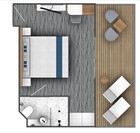
Category A Suite - Junior Suite
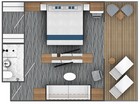
Premium Suite - Freydis Suite
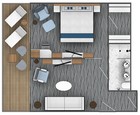
Family Suite - Brynhilde Suite

Category F Stateroom - Triple Stateroom (Porthole)
Category D Stateroom - Albatros Stateroom (Porthole)
Category G Stateroom - Single Stateroom (Porthole)
|
Book now |
Category F Stateroom - Triple Stateroom (Porthole)

Category D Stateroom - Albatros Stateroom (Porthole)

Category E Stateroom - French Balcony Stateroom

Category C Stateroom - Balcony Stateroom

Category G Stateroom - Single Stateroom (Porthole)

Category B Suite - Balcony Suite
 Limited Availability
Limited Availability
Category A Suite - Junior Suite

Premium Suite - Freydis Suite
 Limited Availability
Limited Availability
Family Suite - Brynhilde Suite
 Limited Availability
Limited Availability
Vessel Type: Luxury Expedition
Passenger Capacity: 169 (95 cabins)
Length: 104.4 m
Built: 2022
The Ocean Albatros, sistership to the Ocean Victory, will join the fleet of Albatros Expeditions in November 2022.
The Ocean Albatros will be deployed to a large selection of expedition cruise destinations, Antarctica, the Arctic, any various exciting new destinations in between.
With a total of 95 comfortable staterooms and suites, all with unobstructed sea view, most with their own balcony, the Ocean Albatros will definitely become one of the most popular expedition cruise vessels in the world. Like it's sistership the Ocean Victory it offers two restaurants, a wellness area, an Albatros Nordic Bar, an open deck dining facility, a modern lecture lounge, and other state-of-the-art amenities. The vessel will have more than a 50% lower carbon footprint than traditional expedition vessels and be one of the most environmentally friendly, implementing the Green Initiative Program, ensuring both absolute comfort and sustainability for our guests. Unlike the Ocean Victory, the Ocean Albatros will also offer a unique panorama sauna, and a total of 12 dedicated solo travel cabins without a single-supplement.
BRIDGE
Due to its important role as a control center for all nautical and technical processes, the ship's bridge is a vital, sensitive place. Therefore, the bridge may not be accessible to the public at all times. Conditions permitting, we will be happy to welcome you into the bridge for a visit. Guests must be accompanied by the master or our expedition leader.
STATEROOM SERVICE
Your stateroom is serviced daily. We provide a turn-down service. We provide meal to room only for serious cases of guest being sick. Our suites will have VIP services.
ZODIAC LANDINGS
One feature of our expedition cruises includes landings and excursions aboard Ocean Albatros's fleet of 18 inflatable, motorized rubber "Zodiac" boats. The Zodiac brand has earned a well-deserved reputation as the sturdiest and safest small watercraft available. These boats have a low draft and great stability. Zodiacs are constructed for professional use and are outfitted with a top-quality outboard engine, yet their design minimally impacts the environment.
The Zodiacs are designed to provide unrestricted access to the world’s last great frontier. Their versatility enables us to make landfall on remote shores, cruise along awe-inspiring coastlines and share breathtakingly close encounters with whales, seals, penguins, seabirds and more. We will come within arm’s reach of icebergs and set foot on land discovered by pioneering explorers just over a century ago.
Your safety and comfort are our #1 priority, and your expedition leader will carefully plan for as many Zodiac excursions as possible, dependent upon the local weather and prevailing conditions. In each case, the expedition leader makes the final decision if the landing is possible or not. Safety regulations apply on landings. All guests receive a mandatory instruction of the safety guidelines. Life jackets are mandatory to wear.
Please note, we highly recommend the use of waterproof bags in order to protect your personal camera or binoculars, as both hands must be free of everything during boarding. Participation is fairly easy and comfortable for able-bodied guests but can be more challenging for those with physical handicaps.
GRATUITIES
Following international standards in the service industry, it is customary to leave gratuity for the ship’s crew at the end of the voyage. All gratuities will be divided among the crew. Typically, a recommended amount is approximately 13.5 USD per person per day. Gratuity is, of course, not required and any gratuity payments are voluntary.
DRESS CODE
The dress code on board is casual. Ties, jackets and evening dresses you may leave at home. It is rather more important to wear the right clothes in order to adapt to the different weather conditions. We recommend comfortable, breathable, waterproof and windproof clothing. Also, you should have a pair of gloves, thermal underwear and sturdy footwear in your luggage. For the captains and farewell cocktail, we recommend a smart casual dress style.
INTERNET / PHONE
Keep in mind, we will be cruising in a very remote region of the world. Where accessible, internet access is available for an extra charge. Mobile phone reception may be possible in select regions along our route. For further details please contact your mobile phone operator. Prices can be found in the information folder in your state room. Please ensure that your ‘Data Roaming’ function is switched off.
RECEPTION
The daily office hours of the board reception are from 06:00 until 23:00.
ALBATROS OCEAN SHOP
The selection of items available for purchase varies by ship, and may include a range of warm and practical clothing, as well as souvenirs, local arts and postcards at reasonable prices. A small selection of soap, toothpaste and other personal effects are also sold.
HEALTH / MEDICAL EMERGENCY
Each of our vessels has a small medical facility equipped with the necessary equipment and medicine to handle small emergencies. The infirmary is always staffed by a professionally licensed, English-speaking physician and nurse. Should a serious incident occur, the nearest hospital will be contacted. All guests must have personal travel/health insurance.
Although we do not have an official requirement regarding personal fitness, you should be able to move on board and ashore without the help of others. Please be aware that the ship does not provide wheelchair accessible state rooms.
Due to safety reasons a cruise is only possible for pregnant women until the 24th week of pregnancy. The state of pregnancy must be presented by a medical certificate.
PHYSICAL DISABILITIES / WHEELCHAIR ACCESSIBILITY
Guests with physical disabilities are recommended to travel with an accompanying person. The processes on board should be handled without external help. The gangway can be – depending on the individual disability – a challenge. The angle of inclination of the gangway varies due to tide and different circumstances in the respective port. Please note that the guest’s participation in shore excursions as well as the (dis-)embarkation by Zodiac can be denied by the expedition leader due to security reasons. The instructions of the expedition leader must be followed. The ship is not suitable for wheelchairs.
SEASICKNESS / STABILISATORS
The ship is equipped with stabilizers in order to reduce the ship’s roll. However, these expeditions are hosted in remote regions, and it is possible to periodically encounter changing environments and climate patterns, including rough seas and large swells. Seasickness patches (Scopoderm or similar) work solely or in part to help cure nausea for most people. These medicines can cause sleepiness. If you are prone to motion sickness, consult with your doctor prior to departure to help ensure your comfort while travelling.
SPECIAL DIETARY REQUESTS
All meals on board the vessel is chef-prepared. If you have special dietary requirements (food allergies, intolerances, health conditions or religious preferences), please inform us as early as possible - ideally, no later than 2 weeks before departure. In order to ensure efficient service, please re-confirm your requirements with the crew upon boarding the ship.
LAUNDRY
If you wish to have some laundry done while aboard the ship, laundry service is available for an additional fee.












Kayaking $345 USD
Inclusions
• Voyage in selected cabin category
• Accommodation in shared inside or outside cabins as booked
• English speaking expedition team
• Shore landings by zodiac
• Information briefings and lectures held on board by expedition team
• All meals while on board
• Welcome and farewell cocktails
• Free tea and coffee on board
• Complimentary use of boots for shore landings
• Digital journal link after voyage (Includes voyage log, gallery, species list and more)
• Port Fees, taxes and AECO fees and tariffs
________
• 2025 Flights between Kangerlussaq - Copenhagen via Keflavik and Group Transfer between Kangerlussaq Airport and the vessel
Exclusions
• Flights to/from departure port unless specified in itinerary
• Hotel accommodations unless specified in itinerary
• Travel Insurance
• Cancellation insurance
• Additional excursions and activities not mentioned in itinerary
• Meals when not on board the ship
• Beverages other than tea/coffee and water
• Gratuities for crew (recommended USD$14.00 per passenger per day)
• Any items of a personal nature
Highlights
• LECTURES - Our primary focus is knowledge, and we apply this to every aspect of a journey. From the staff that forms our expedition team, to the routes our ship follows, and of course, the program onboard• ZODIAC - Essential for expedition cruises, Zodiacs are robust boats that can go up on a beach, a rocky outcrop, a river bank or even an ice floe push through bergy bits of ice floating in the water
Our Associates Include













